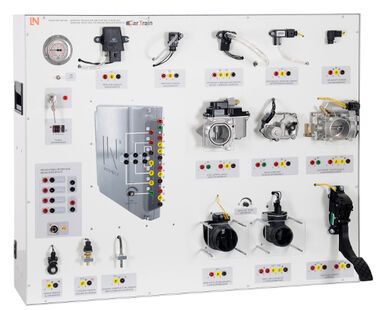CarTrain "Sensors, open- and closed-loop control systems"

The subject of sensors is already a core subject of training in the area of service, repairs and diagnostics. The sensors in the motor vehicle are digitally networked and in recent years have taken on ever greater importance. The number of sensors inside the motor vehicle has also increased dramatically. How sensor signals are evaluated is also becoming more and more important in practical everyday diagnostics. The way sensors and actuators interact via open- and closed-loop controlled systems has also continued to become more complex. In this training system signals are recorded and evaluated using hands-on measuring and testing methods. Faults and malfunctions are diagnosed on vehicles based on customer complaints and by applying hands-on methods working with circuit diagrams and function diagrams. Measurements are performed using the integrated measurement interface and with the aid of all other suitable measuring instrument found in the repair shop.
Scope of supply:
- CarTrain “Sensors, open- and closed-loop control systems” (CO3221-6N)
- Integrated measurement interface
- Set of safety measurement leads
- Interactive course on CD-ROM with Labsoft browser, course software and additional virtual instruments
Virtual measuring instruments
- Digitally networked measuring option (WLAN-capable or using cables)
- 4-channel oscilloscope
- Voltmeter
- Ammeter
- Double voltmeter
- Power meter
- Function generator
- Pulse generator
Training contents:
- Investigate customer complaints, perform operation checks and establish diagnostics methods
- Read out fault memory
- Work safety
- Become familiar with where components are in the vehicle
- Determine faults and their causes with the aid of circuit diagrams and functional plans
- Create inspection record and document results
- Find out how data communication works between the component and the control unit
- Recognise what the repair options are
- Perform system measurements and tests
- Determine the target data
- Select appropriate measurement methods and instruments
- Document measurement values
- Compile measurement values, compare these to target data and evaluate
- Measure signals to components and measure, test and evaluate systems
- Measure, test and evaluate electrical connections
- Design and function of pressure sensors
- Design and function of temperature sensors
- Design and function of air-quality sensors
- Advantages and disadvantages of individual sensor types
- Measurement options for recording the signals from various types of sensors in actual practice
- Measurement prerequisites for recording signals from various types of sensors in actual practice
- How sensors and actuators interact
- IPO principle
- Open-loop control processes in the motor vehicle
- Closed-loop control processes in the motor vehicle
- Difference between open- and closed-loop control
Components used in the experiment hardware:
- Fault simulation switches operational via WLAN
- Ignition switch
- Automotive fuses
- Intake manifold pressure sensor, frequency-controlled
- Intake manifold pressure sensor, analog for low-pressure and excess pressure measurements
- Intake manifold pressure sensor, analog with temperature detection
- Differential pressure sensor
- Air-quality sensor
- EGR valve with sensor and actuator
- Actuator motor with sensor and actuator
- E-gas throttle valve with sensors and actuator
- Knock sensor
- Temperature sensor for water cooler
- Temperature sensor for intake air temperature
- Temperature sensor for exhaust gas temperature
- Mass air-flow sensor PWM
- Mass air-flow meter, analog
- Electrically operated accelerator pedal with contactless sensors
- Control unit for connection to sensors and actuators
- Manometer for display of excess pressure and low-pressure levels
- Air connection terminal
- Automatic air-flow rate control for mass air-flow meter
- PWM generator for control system
- Automatic control of hardware components using measurement options
- 4-mm safety measurement plugs
- Connection slots for pull-up and pull-down resistors
- USB port
- 32 fault simulation options for diagnostics
Power supply:
Operating voltage:
Dimensions:
- approx. 350 x 1010 x 805 (LxWxH in mm)